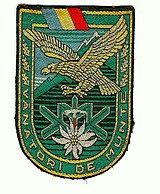Vânători de munte
| Mountain Huntsmen | |
|---|---|
| Vânători de munte | |
The Vânători de Munte (Romanian pronunciation:
History
Origins and World War I
In 1883, the Mountain Artillery was formed with one battery assigned to each of the four Army Corps. In 1913 and 1915, two
Despite several initiatives starting in 1889,[2] the first mountain troops were formed in November 1916. Through Order no. 294, the Military School of Skiing was transformed in the "Corps of Mountain Hunters" (Corpul Vânătorilor de munte). It was organized in three battalions, each with three companies. In January 1917, the Corps was reorganized into the "Mountain Hunter Battalion" (Batalionul Vânătorilor de Munte). It consisted of 5 infantry companies, 2 machine gun companies and a wireless telegraphy section.[1] Each company took a nickname: the 1st was nicknamed Tigrii, the 2nd Șoimii, the 3rd Haiducii, the 4th Leii, and the 5th Pandurii, while the 1st and 2nd machine gun companies were nicknamed Smeii and Balaurii respectively. This tradition was kept until after the Second World War.[3]
The Mountain Hunter Battalion first saw combat during the Third Battle of Oituz. The vânători de munte companies were deployed at Cireșoaia and Coșna, where between 20th and 26 August they fought against the Württemberg mountain battalion of the German Alpenkorps, winning the engagement. The Germans eventually managed to take the two peaks, but failed to break the Romanian lines further.[3] On 30 October 1917, the Battalion was transformed into a Regiment, and Prince Carol was named as its honorific commander. From March 1919, the Regiment participated in the Hungarian–Romanian War.[4]
Interwar to World War II

In 1923, the first two vânători de munte divisions were formed: the 1st Division at Brașov, and the 2nd Division at Bistrița. The foundations of training, rules and principles of fighting in the mountains were also laid out.[1]
The Romanian vânători de munte saw action in

After the end of the war, one of the first measures taken by the
There are currently two brigades operational, one subordinated to the 1st Infantry Division (the 2nd Mountain Troops Brigade "Sarmizegetusa"), and another one subordinated to the 4th Infantry Division (the 61st Mountain Troops Brigade "General Virgil Bădulescu"). Mountain troops units participated in the occupation of Iraq and Afghanistan.[7]
Image gallery
-
Romanian mountain troops 1970s
-
Vânători de munte during a military competition
-
Troops from the 2nd and 61st Mountain Troops Brigade during a military competition
-
A soldier with the 17th Vânători de munte Battalion fires an M240B machine gun with a U.S. Marine of the Black Sea Rotational Force, during a live-fire exercise in the Carpathian Mountains, 2014
-
An Arctic Cat Prowler used by the 21st Mountain Hunters Battalion "General Leonard Mociulschi" during a training exercise, 2017
See also
- List of mountain warfare forces
- Mountain warfare
- Ski warfare
- French Chasseurs Alpins
- German Gebirgsjäger
- Italian Alpini
- Polish Podhale rifles
- 10th Mountain Division (United States)
References
- ^ a b c d "Vânători de munte". www.forter.ro (in Romanian). Romanian Land Forces. Retrieved 3 November 2022.
- ^ a b Suman 2014, pp. 14–15.
- ^ a b Suman 2014, pp. 16–19.
- ^ Suman 2014, pp. 20–21.
- ^ Spencer C. Tucker, World War II: The Definitive Encyclopedia and Document Collection (5 volumes), ABC-CLIO, 2016, p. 1422
- OCLC 32552622.
- ^ "Forter.ro:La kilometrul zero al infanteriei". Archived from the original on 19 January 2015. Retrieved 19 January 2015.
Bibliography
- Suman, Gheorghe (2014). "Vânătorii de munte". Tactică și Strategie (in Romanian).
External links
- (in Romanian) Presentation of the vânători de munte on the Land Forces' website
- (in English) Unofficial page
- (in English) "The Mountain Troops"






